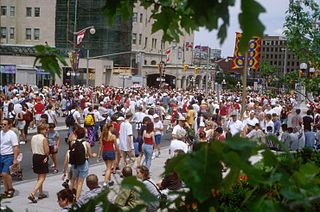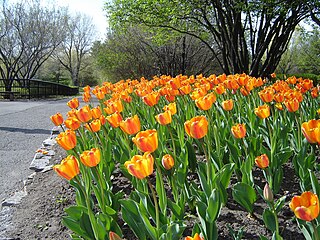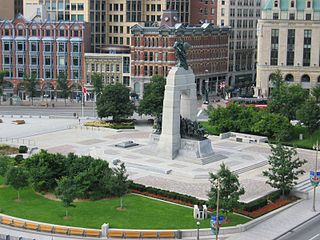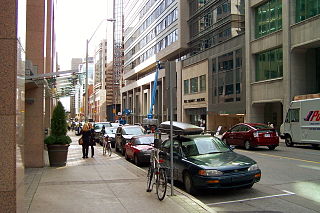
The Office of the Prime Minister and Privy Council building, formerly known as the Langevin Block, is an office building facing Parliament Hill in Ottawa, Ontario, Canada. As the home of the Privy Council Office and Office of the Prime Minister, it is the working headquarters of the executive branch of the Canadian government.

Wellington Street is a major street in Ottawa, Ottawa, Canada. The street is notable for being the main street of the Parliamentary Precinct of the Parliament of Canada. It is one of the first two streets laid out in Bytown in 1826. The street runs from Booth Street to the Rideau Canal where it connects with Rideau Street and delimits the northern border of the downtown core. It is named after the Duke of Wellington, in recognition of his role in the creation of the Rideau Canal, and therefore of Ottawa.

Sparks Street is a pedestrian mall in Ottawa, Ontario, Canada. It was a main street in Ottawa that was converted into an outdoor pedestrian street in 1967, making it the earliest such street or mall in Canada.

The National Capital Region, also referred to as Canada's Capital Region and Ottawa–Gatineau, is an official federal designation for the Canadian capital of Ottawa, Ontario, the neighbouring city of Gatineau, Quebec, and surrounding urban and rural communities. The term National Capital Region is often used to describe the Ottawa–Gatineau metropolitan area, although the official boundaries of the NCR do not precisely correspond to the statistical metropolitan area.

Downtown Ottawa is the central area of Ottawa, Ontario, Canada. Like other downtowns it is the commercial and economic centre of the city. It is sometimes referred to as the Central Business District and contains Ottawa's financial district. It is bordered by the Ottawa River to the north, the Rideau Canal to the east, Gloucester Street to the south and Bronson Avenue to the west. This area and the residential neighbourhood to the south are also known locally as 'Centretown'. The total population of the area is 4,876.

The CBC Ottawa Broadcast Centre is an office and studio complex located on Sparks Street in downtown Ottawa, Ontario, Canada. Its primary tenant is the Canadian Broadcasting Corporation, with the building serving as the corporate headquarters of the CBC and hosting the originating studios for the CBC's various English and French language operations in the National Capital Region. The building was opened in 2004, and contains approximately 37,700 square metres of office space.

The Canadian Tulip Festival is a tulip festival, held annually in May in Ottawa, Ontario, Canada. The festival claims to be the world's largest tulip festival, displaying over one million tulips, with attendance of over 650,000 visitors annually. Large displays of tulips are planted throughout the city, and the largest display of tulips is found in Commissioners Park on the shores of Dow's Lake, and along the Rideau Canal with 300,000 tulips planted there alone. Millions of tulips set the stage for a celebration of authentic art, cultural, historic, culinary and family tulip experiences at various official venues across the capital.

The history of Northwest Territories capital cities begins with the purchase of the Territories by Canada from the Hudson's Bay Company in 1869, and includes a varied and often difficult evolution. Northwest Territories is unique amongst the other provinces and territories of Canada in that it has had seven capital cities in its history. The territory has changed the seat of government for numerous reasons, including civil conflict, development of infrastructure, and a history of significant revisions to its territorial boundaries.

The Sir John A. Macdonald Parkway, formerly the Ottawa River Parkway, is a four-lane scenic parkway along the Ottawa River in Ottawa, Ontario, Canada. It runs from Carling Avenue near Connaught Avenue, to Booth Street at the Canadian War Museum and National Holocaust Monument. It is maintained by the National Capital Commission. The speed limit is 60 km/h (37 mph). Bicycles are allowed on the road and on a parallel recreational path along the parkway.

Confederation Park(French: Parc de la Confédération) is a public park and National Historic Site of Canada, located in downtown Ottawa, Ontario, Canada. It is bordered on the south by Laurier Avenue and Ottawa City Hall; on the east by the Rideau Canal and National Defence Headquarters; on the north by the Mackenzie King Bridge, the Rideau Centre, and the National Arts Centre; and, to the west, by Elgin Street and the Lord Elgin Hotel.

Located on Parliament Hill in Ottawa, Ontario, Canada, the Centennial Flame commemorates Canada's 100th anniversary as a Confederation. The Flame was first lit as the climax of the centennial celebrations of January 1, 1967, in the presence of then Prime Minister Lester B. Pearson. He was joined on the hill by leader of the Opposition and former Prime Minister, John Diefenbaker, and Secretary of State, who was in charge of the Centennial, Judy LaMarsh as well as thousands of onlookers. The Flame is fuelled by natural gas and surrounded by a fountain whose ledge contains the shields of Canada's 13 provinces and territories—Nunavut was originally absent as it was not created until 1999. On December 13, 2017, a Nunavut plaque was unveiled.
The Plaza Bridge in Ottawa, Ontario, Canada is an automotive and pedestrian bridge that crosses the Rideau Canal just south of the Ottawa locks. It joins Wellington Street and Elgin Street in the Downtown core to the west with Rideau Street to the east. The Chateau Laurier abuts the bridge at the east end, while Parliament Hill is just beyond the west end. It is the northernmost bridge over the canal, just north of the Mackenzie King Bridge.

Confederation Square is an urban square in Ottawa, Ontario, Canada, and is considered the second most important ceremonial centre in Canada's capital city, after Parliament Hill. Roughly triangular in area, with Canada's National War Memorial at its centre and the Valiants Memorial at its periphery, the square is bounded by Wellington Street to the north and branches of Elgin Street to the east and west.
The History of Ottawa, capital of Canada, was shaped by events such as the construction of the Rideau Canal, the lumber industry, the choice of Ottawa as the location of Canada's capital, as well as American and European influences and interactions. By 1914, Ottawa's population had surpassed 100,000 and today it is the capital of a G7 country whose metropolitan population exceeds one million.
The Memorial to the Victims of Communism – Canada, a Land of Refuge is a controversial monument that is being built in Ottawa, Ontario, Canada. It was originally to be erected on a site between the Supreme Court of Canada and the National Library of Canada but in December 2015, Canadian Heritage Minister Mélanie Joly suggested that the National Capital Commission instead approve a 500 square metre site half a kilometre to the west, in the Garden of the Provinces and Territories. Under the revised timeline, a national competition was held in 2016 and 2017 to select a new design for the monument. The site was dedicated in a ceremony held on November 2, 2017. Construction is to begin in early 2018 and to be completed by late 2018 or early 2019.

Queen Street is an east-west arterial road located in Downtown Ottawa, Ontario, Canada. The street is two-way with one to two lanes going in each direction. The Confederation Line will run underneath Queen Street when it opens.

























